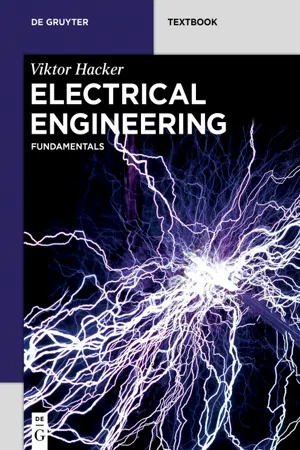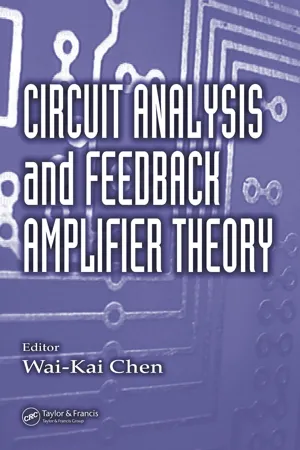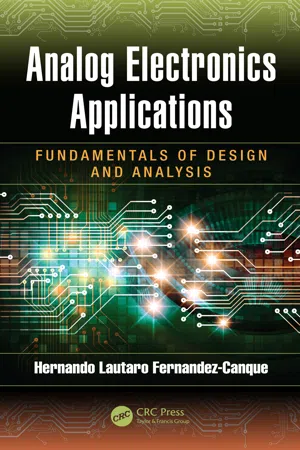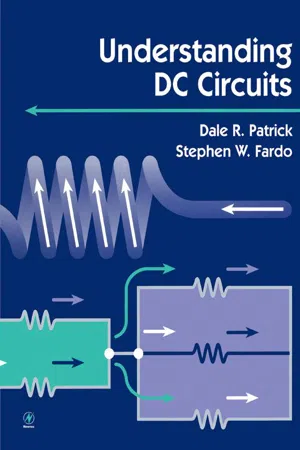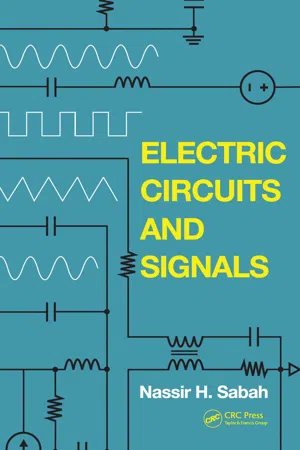Physics
Simple Circuit
A simple circuit is a basic electrical circuit that consists of a power source, a load, and conductive wires connecting them. It allows the flow of electric current from the power source to the load and back. Simple circuits are fundamental to understanding the principles of electricity and are often used as building blocks for more complex electrical systems.
Written by Perlego with AI-assistance
Related key terms
Related key terms
1 of 4
Related key terms
1 of 3
10 Key excerpts on "Simple Circuit"
- eBook - ePub
- U.S. Bureau of Naval Personnel(Author)
- 2012(Publication Date)
- Dover Publications(Publisher)
In this respect, schematic symbols aid the technician in the same way that shorthand aids the stenographer. In previous chapters the schematic symbols for cells and resistances were presented. These symbols will now be used to discuss the circuits of figure 4-1. A schematic diagram of a basic circuit is shown in figure 4-2. The battery is designated by the letter symbols E bb, the light bulb in the circuit is labeled R 1. Since in reality the light bulb element is nothing more than a wire wound resistor, the conventional resistor symbol is used for the bulb in this discussion. It should be noted, however, that the light bulb has its own specific schematic symbol and is not normally drawn as a resistor. The standard symbol used for a light bulb is discussed at a later time when need arises. In studies of electricity and electronics many circuits are analyzed which consist mainly of specially designed resistive components. As previously stated, these components are called resistors. Throughout the remaining analysis of the basic circuit, the resistive component will be a physical resistor. However, the resistive component could be any one of several electrical devices. A closed loop of wire (conductor) is not necessarily a circuit. A source of voltage must be included to make it an electric circuit. In any electric circuit where electrons move around a closed loop, current, voltage, and resistance are present. The physical pathway for current flow is actually the circuit. Its resistance controls the amount of current flow around the circuit. By knowing any two of the three quantities, such as voltage and current, the third (resistance) may be determined. This is done mathematically by the use of Ohm’s LAW. OHM’S LAW In the early part of the 19th century Georg Simon Ohm proved by experiment that a precise relationship exists between current, voltage, and resistance - eBook - ePub
- Daniel McBrearty(Author)
- 1998(Publication Date)
- Newnes(Publisher)
IR.Circuits, diagrams and common expressions
A circuit is exactly what its name suggests; a loop around which electric current can flow. The loop is generally made up of conductors (bits of wire or otherwise), circuit elements or components (which we start to meet soon) and one or more sources of electrical energy – current or voltage.Circuit diagrams, sometimes called schematic diagrams, are symbolic representations of the way that the components of a circuit are interconnected. They are the starting point for most designs, and invaluable aid in servicing or faultfinding equipment that already exists. Each element of the circuit, from a battery or a tiny resistor to a complex microprocessor chip, is represented by a symbol, with each connection to it represented by a line joining to it. Interconnections between elements are shown by lines drawn between components. In reality, these could be any form of conductor; a wire soldered directly to a leg of the component (not recommended for a microprocessor!), a copper track on a PCB, or a test lead with a crocodile clip at either end of it.Sometimes a circuit diagram doesn’t show all of the circuit, and you can’t see all of the loop around which the current will flow. (For example, see Figure 2.2 later.) The inference here is that things start to happen when something else is connected to it, completing the circuit – in this case a DC voltage (as you will see).‘Block diagrams’ are a special type of circuit diagram worthy of explanation. You generally find them with fairly complex electronic circuits which are either too large to see on one drawing, or more understandable by being broken into smaller parts. Each ‘circuit block’ is drawn as a box or some commonly understood symbol, with lines connecting the blocks. The lines represent ‘signals’ (in reality any means by which the individual circuits can communicate), generally one or more conductors carrying voltage or current. It is the job of the person drawing the block diagram to make it less vague than this definition! - eBook - ePub
Electrical Engineering
Fundamentals
- Viktor Hacker, Christof Sumereder(Authors)
- 2020(Publication Date)
- De Gruyter Oldenbourg(Publisher)
1 The basic physic principles and definitions1.1 The Simple Circuit
In everyday life, people do not distinguish between technically correct designations for electric quantities but abbreviate and incorrectly name it “electricity”. Colloquially, the expression “electricity bill” is used, when in reality the electrical energy consumption is meant; when an electrical accident happens, it is referred to as “electric shock”.A person with technical knowledge is aware that a flow of an electric charge is designated “electric current” and that the physical quantity of current (intensity) uses the unit ampere. Furthermore, an expert knows that it is the voltage (measured in volts) that drives the current and that resistance (measured in ohm) at constant voltage determines the current (Figure 1.1 ).To better understand the correlation between electric current, voltage and resistance, we look at the water cycle as analogue to the electric circuit.Figure 1.1: Correlation between current, voltage and resistance.Table 1.1: Water cycle as analogue to electric circuit.Water cycle (analogue) Electric circuit Figure 1.2: Closed water cycle.Figure 1.3: Closed circuit.The flow of water is caused by the pressure differenceQ tΔ Pgenerated by pump P.The current flow is caused by the potential difference (= voltage V ) generated by the voltage source. The pressure difference Δ Pdetermines the amount of water pumped via the load per time.The potential difference (voltage V ) determines the electric charge per time (current I) flowing through the load. The pressure loss due to the resistance in the container C is as high as the pressure difference Δ P - eBook - ePub
- Wai-Kai Chen, Wai-Kai Chen(Authors)
- 2018(Publication Date)
- CRC Press(Publisher)
1 Fundamental Circuit Concepts 1.1 The Electrical CircuitCurrent and Current Polarity • Energy and Voltage • Power1.2 Circuit Classifications • Linear vs. Nonlinear • Active vs. Passive • Time Varying vs. Time Invariant • Lumped vs. DistributedJohn Choma, Jr. University of Southern California 1.1 The Electrical CircuitAn electrical circuit or electrical network is an array of interconnected elements wired so as to be capable of conducting current. As discussed earlier, the fundamental two-terminal elements of an electrical circuit are the resistor, the capacitor, the inductor, the voltage source, and the current source. The circuit schematic symbols of these elements, together with the algebraic symbols used to denote their respective general values, appear in Figure 1.1 .As suggested in Figure 1.1 , the value of a resistor is known as its resistance, R, and its dimensional units are ohms. The case of a wire used to interconnect the terminals of two electrical elements corresponds to the special case of a resistor whose resistance is ideally zero ohms; that is, R = 0. For the capacitor in Figure 1.1(b) , the capacitance, C, has units of farads, and from Figure 1.1(c) , the value of an inductor is its inductance, L, the dimensions of which are henries. In the case of the voltage sources depicted in Figure 1.1(d) , a constant, time invariant source of voltage, or battery, is distinguished from a voltage source that varies with time. The latter type of voltage source is often referred to as a time varying signal or simply, a signal. In either case, the value of the battery voltage, E, and the time varying signal, v(t), is in units of volts. Finally, the current source of Figure 1.1(e) has a value, I, in units of amperes, which is typically abbreviated as amps.Elements having three, four, or more than four terminals can also appear in practical electrical networks. The discrete component bipolar junction transistor (BJT), which is schematically portrayed in Figure 1.2(a) , is an example of a three-terminal element, in which the three terminals are the collector, the base, and the emitter. On the other hand, the monolithic metal-oxide-semiconductor field-effect transistor (MOSFET) depicted in Figure 1.2(b) - eBook - ePub
Analog Electronics Applications
Fundamentals of Design and Analysis
- Hernando Lautaro Fernandez-Canque(Author)
- 2016(Publication Date)
- CRC Press(Publisher)
For convenience the point of high potential is termed the positive and the point of low potential is termed the negative, hence conventionally a current is said to flow from positive to negative. Because electrons are assumed to have negative charge, conventional current flow is in the opposite direction to that of an electron flow. This can create some confusion in the analysis of circuits. Later in the book we will develop a way of avoiding any confusion in determining value or direction of currents in active or passive components.In any practical application, it is required that the current flow continuously for as long as it is needed. In order to obtain a current in a circuit it is necessary that two conditions must be fulfilled:1.There must be an entire circuit around which the electrons may move. 2.There must be a driving stimulus to cause the continuous flow.These two conditions will lead to the concept f circuit and electromotive force (emf).2.4.1CIRCUITThe path required to allow electrons to move to fulfill condition 1. This path will generate what is known as the electric circuit.2.4.2ELECTROMOTIVE FORCEThe driven stimulus required to fulfill condition 2 is known as the electromotive force (emf). Each time a charge passes through the source energy provided by the emf the continuous current flow is maintained.2.4.3SOURCEAn element that provides electrical energy supplied to a circuit is termed a source. The emf in a circuit is provided by source energy such as a battery or a generator and is measured in volts. A change in electric potential between two points in an electric circuit is called a potential difference.2.4.4LOADWhen a current is established in a circuit, some elements in this circuit will absorb or convert the electrical energy supplied by the source. An element that absorbs and/or converts the electrical energy supplied by the source is termed a load.We can classify electrical elements in a circuit according to whether they provide energy to the circuit as active components or whether they absorb or convert energy to a circuit as passive components.2.5PASSIVE COMPONENTS: RESISTANCE, INDUCTANCE, AND CAPACITANCEPassive components in an electric circuit are components that do not add energy to the circuit. They usually dissipate or transform energy. There are different types of passive components according to their relationship between their voltages and currents. - Miguel F. Acevedo(Author)
- 2018(Publication Date)
- CRC Press(Publisher)
3 Fundamentals of Direct Current Electric CircuitsThis chapter is one of several providing a very basic review of those major concepts of electrical circuits that we need in order to understand electrical power systems. In this chapter, we review basic electrical quantities and circuits, introducing Ohm’s law and the fundamentals of circuit analysis methods including Kirchhoff’s voltage and current laws, nodal and mesh analysis, and Thévenin and Norton theorems. In preparation for understanding power transfer, we cover modeling of voltage and current sources and the basics of maximum power transfer. In this chapter, we will focus on direct current (DC) circuits, and later, in Chapter 5 , we introduce alternating current (AC) circuits. This topic is expanded in Chapter 8 discussing AC circuit analysis and power calculation for AC circuits, and in Chapter 10 when we introduce transformers and three-phase circuits. Basic DC circuit analysis is covered in many textbooks used in introductory circuit analysis courses and can serve as supplementary material [1–3 ]. Reviews are also available in textbooks devoted to renewable energy [4 ,5 ].3.1 Basics of Electric Circuits3.1.1 Principles of Electrical QuantitiesElectrical charge is a fundamental property of matter that can both generate and interact with electromagnetic fields. Charge can be positive or negative; at the subatomic level, protons represent positive charge, whereas electrons have negative charge. The unit of charge is the coulomb or C, where 1 C is the equivalent charge of 6.2 × 1018 electrons. In a conductor, free electrons can flow and represent a movement of negative charge.Voltage is the potential energy difference between two points in an electric field, measured per unit charge. Being potential energy means it is available to perform the work of moving a unit charge against an electric field. Intuitively, voltage is the energy available to cause electrons to flow through a conductor. Its unit is volt or V, which is defined as joule/coulomb (J/C), and is named volt in honor of Alessandro Volta. In general, work and charge vary with time. Denoting charge by q , voltage by v , and work by w- eBook - ePub
- Roy D. Treloar(Author)
- 2011(Publication Date)
- Wiley-Blackwell(Publisher)
Part 6: Electrical Work Basic Electrical TheoryElectricity is the flow of free electrons moving along a conductor. Free electrons are small electrical charges moving round an atom. Millions of atoms make up a solid conductor, such as copper, but the electrical charge is not felt because the electrons are moving in all directions. It is when all these electrons are made to travel in the same direction that the electrical current is produced. A flow of about 6 billion electrons per second produces a current of about 1 ampere .Electricity will not flow through certain materials, such as wood or plastic, because there are no free electrons in these materials. These materials are therefore known as insulators. To make the free electrons flow in the same direction, an electromotive force (emf), expressed in volts , needs to be applied, such as that produced by a battery or generator. The flow of free electrons can only occur if the electrons have somewhere to go, which is achieved by allowing the electrons to flow in a circuit. Break the circuit and the electron flow (current) will stop.ResistanceAs the electrons flow through the cable they slowly lose their ability to move (emf). When the electrons are forced to pass through thin sections they all rub together in order to get through; thus they are restricted and once again there is a drop in emf. This voltage drop is due to the resistance of the system and its components; resistance is measured in ohms (Ω).The relationship between current (amps), emf (volts) and resistance (ohms) is expressed in Ohm’s Law :Example: where a 12 volt battery is used to serve a circuit in which the total resistance is 4 ohms the current flow will be 12 ÷ 4 = 3 amps. Note: increasing the voltage increases the amperes.PowerWhen the electrical energy produced is used up very quickly, such as in passing through a light bulb filament, heat energy is produced, due to resistance; this is referred to as power and is measured in watts - eBook - ePub
- Trevor Linsley(Author)
- 2014(Publication Date)
- Routledge(Publisher)
Fig. 8.1(b) , the free electrons drift purposefully in one direction only. The free electrons close to the positive plate of the battery are attracted to it, since unlike charges attract, and the free electrons near the negative plate will be repelled from it. For each electron entering the positive terminal of the battery, one will be ejected rrom the negative terminal, so the number of electrons in the conductor remains constant.This drift of electrons within a conductor is known as an electric current, measured in amperes and given the symbol I. For a current to continue to flow, there must be a complete circuit for the electrons to move around. If the circuit is broken by opening a switch, for example, the electron flow, and therefore the current, will stop immediately.To cause a current to flow continuously around a circuit, a driving force is required, just as a circulating pump is required to drive water round a central heating system. This driving force is the electromotive force (abbreviated to emf) and is the energy which causes the current to flow in a circuit. Each time an electron passes through the source of emf, more energy is provided to send it on its way around the circuit.An emf is always associated with energy conversion, such as chemical to electrical in batteries and mechanical to electrical in generators. The energy introduced into the circuit by the emf is transferred to the load terminals by the circuit conductors. The potential difference (abbreviated to p.d.) is the change in energy levels measured across the load terminals. This is also called the volt drop or terminal voltage, since emf and p.d. are both measured in volts. Every circuit offers some opposition to current flow which we call the circuit resistance measured in ohms, to commemorate the famous experimenter George Simon Ohm, who was responsible for the analysis of electrical circuits. The symbol Q represents an ohm.In 1826, Ohm published details of an experiment he had made to investigate the relationship between the current passing through and the potential difference between the ends of wire. As a result of this experiment he arrived at the following law, known as Ohm’s law. - eBook - ePub
- Dale Patrick, Stephen Fardo(Authors)
- 1999(Publication Date)
- Newnes(Publisher)
Before reading this unit, review the following terms. These terms provide a basic understanding of some of the concepts discussed. As you read other units, you may find it necessary to review these terms.Ampere (A) The unit of electric charge, which is the basic unit of measurement for current flow in an electric circuit.Atom The smallest particle to which an element can be reduced and still retain its characteristics.Atomic number The number of particles called protons in the nucleus (center) of an atom.Closed circuit A circuit that forms a complete path so that electric current can flow through it.Compound The chemical combination of two or more elements to make an entirely different material.Conductor A material that allows electric current to flow through it easily.Control The part of an electric system that affects what the system does; a switch to turn on and turn off a light is a type of control.Conventional current flow Current flow assumed to be in a direction from high charge concentration (+) to low charge concentration (–).Coulomb (C) A unit of electric charge that represents a large number of electrons.Current The movement of electric charge; the flow of electrons through an electric circuit.Electromotive force (EMF) The pressure, or force, that causes electric current to flow.Electron An atomic particle said to have a negative (–) electric charge; electrons are the means by which the transfer of electric energy takes place.Electron current flow - eBook - ePub
- Nassir H. Sabah(Author)
- 2017(Publication Date)
- CRC Press(Publisher)
2Basic Circuit Connections and Laws
Overview
There are two basic circuit laws, known as Kirchhoff’s laws, which are expressions of conservation of charge and conservation of energy. They must be obeyed, therefore, by electric circuits under all conditions, independently of the circuit configuration and the circuit elements involved.Kirchhoff’s laws are first applied in this chapter to analyze some Simple Circuits, namely, resistive voltage dividers and current dividers. These Simple Circuits feature the two basic circuit connections: the series and parallel connections. Circuit elements connected in series or in parallel can be combined with other circuit elements in series or in parallel combinations to obtain circuits of any desired complexity. When resistors are connected in series or in parallel, the individual resistances or conductances combine according to some simple rules to give an equivalent resistance or conductance. The concept of equivalence is fundamental to circuit analysis and is applied to the Δ-Y transformation and transformation between voltage and current sources.The voltage divider supplying a load at a reduced voltage is considered at the end of the chapter to illustrate a common and important feature of engineering design in general, namely, the trade-off between conflicting performance requirements. The example also illustrates the practical effects of tolerance of resistance values due to inevitable variations in component values during manufacturing.
Index pages curate the most relevant extracts from our library of academic textbooks. They’ve been created using an in-house natural language model (NLM), each adding context and meaning to key research topics.
Explore more topic indexes
Explore more topic indexes
1 of 6
Explore more topic indexes
1 of 4


